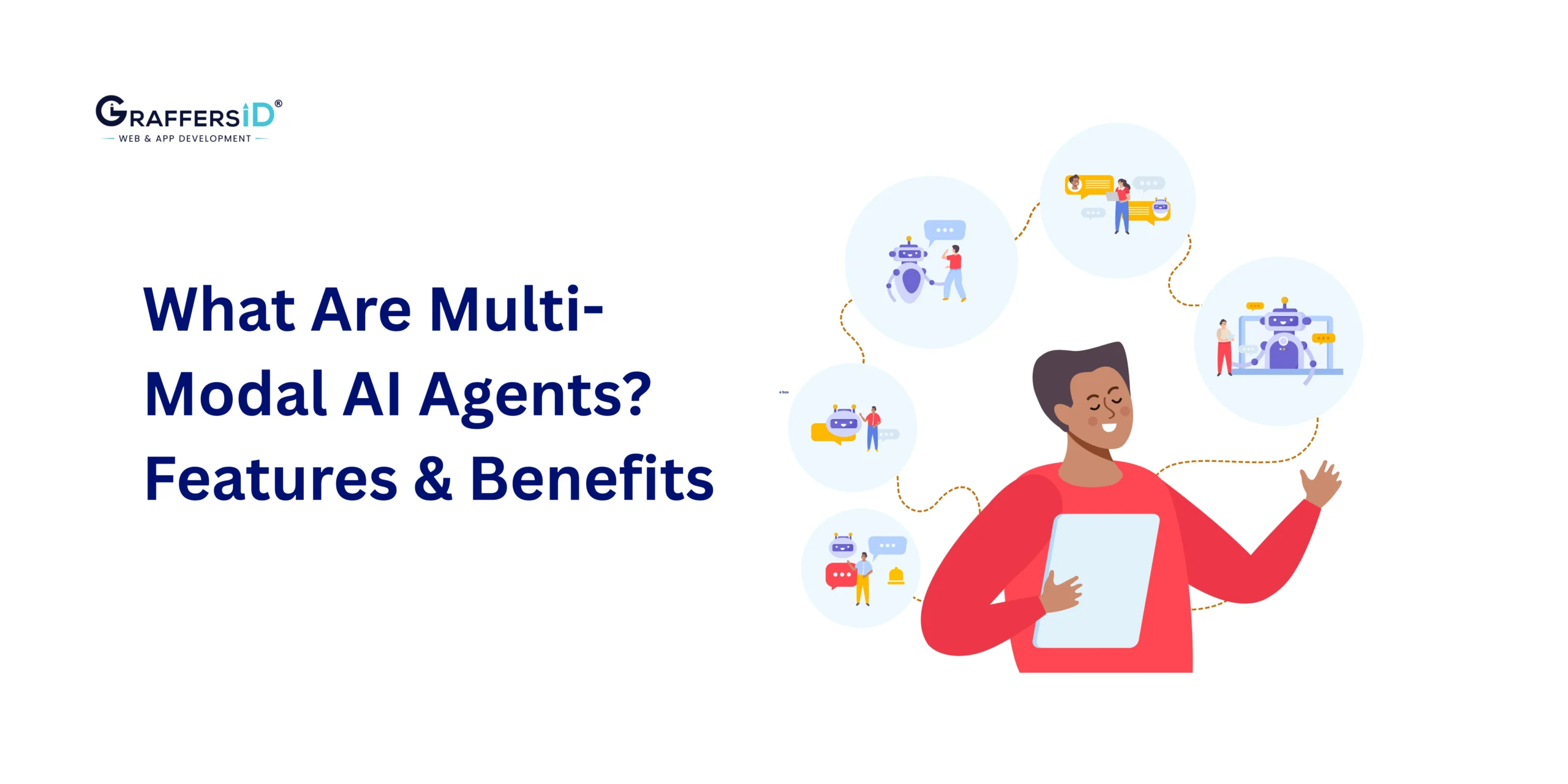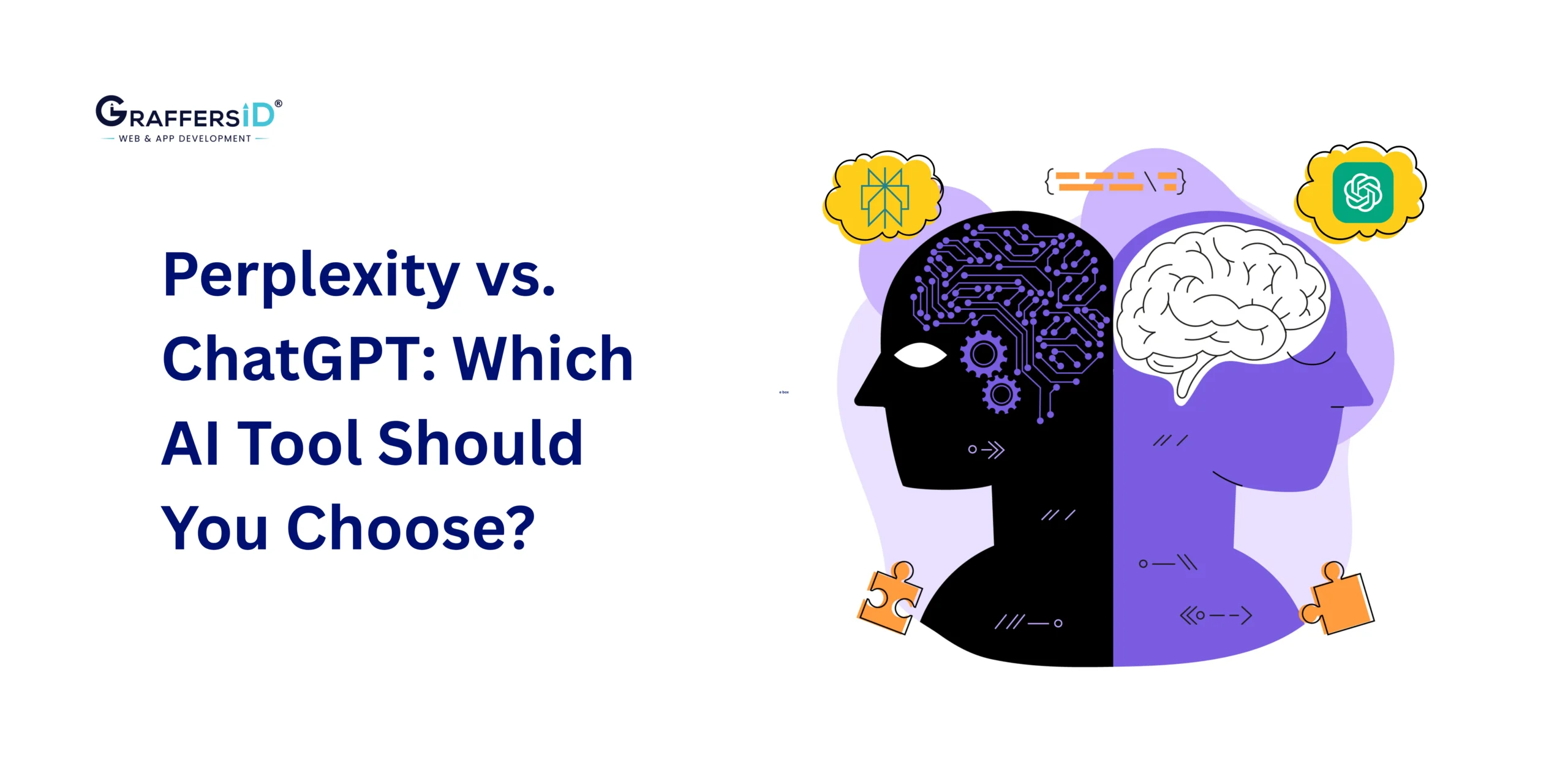In 2026, social media platforms have transformed into intelligent ecosystems powered by AI, automation, real-time data, and privacy-first engineering. Beyond simple posts and messaging, modern social apps demand live streaming, hyper-personalized recommendations, real-time notifications, and privacy-compliant architecture.
Choosing the right programming language (or stack) is no longer just a technical decision; it’s a business-critical move that determines speed, scalability, security, and AI integration.
This guide breaks down the top 7 programming languages for social media app development in 2026, including their strengths, AI capabilities, real-world use cases, and best-fit scenarios for startups and enterprises.
How to Choose the Best Programming Language for a Social Media App in 2026?
Before we dive into the top languages, it’s crucial to understand what separates a future-proof choice from a risky one in 2026. Social media platforms today aren’t just about sharing posts; they handle real-time communication, AI-driven recommendations, data-heavy feeds, and global-scale concurrency.
Below are the key factors that define the best programming languages for building high-performance, AI-powered social networking platforms in 2026:

1. Performance, Concurrency & Real-Time Processing
Modern social media apps demand instant interactions, from live chats to video streaming. The programming language must efficiently handle real-time events and massive concurrent connections.
-
WebSockets & Event-Driven Architecture: Enables smooth data exchange for chat, notifications, and live content.
-
Efficient Threading & Async I/O: Supports millions of active users simultaneously without lag.
-
Low-Latency Response Times: Critical for delivering uninterrupted feeds and instant reactions.
2. Scalability & Microservices Readiness
As your user base grows, scalability determines whether your app can sustain performance without major rework.
-
Microservices Architecture Support: Allows independent scaling of app components like feeds, messages, or media uploads.
-
Containerization (Docker/Kubernetes): Simplifies deployment, scaling, and load balancing.
-
Horizontal Scaling & Sharding: Essential for high-traffic global platforms.
3. Security, Privacy & Data Protection
With increasing cyber threats and compliance regulations (like GDPR and CCPA), your chosen language must simplify secure coding practices and data handling.
-
Memory Safety: Prevents leaks, overflows, and race conditions.
-
Built-In Encryption Support: Protects sensitive user and message data.
-
API Security & DDoS Protection: Shields the platform from unauthorized access and high-volume attacks.
4. AI & Machine Learning Ecosystem
AI is now the core of social media, powering everything from personalized feeds to content moderation and chatbots.
-
Interoperability with ML Frameworks: Languages that easily integrate with TensorFlow, PyTorch, or OpenAI APIs are more future-ready.
-
NLP & Vision Support: Enables sentiment analysis, recommendation engines, and facial recognition features.
-
Embedding & Model Serving: Simplifies integrating custom AI modules for smarter engagement.
5. Ecosystem, Libraries & Community Support
Building a social media platform involves complex systems, real-time APIs, content feeds, analytics, and moderation tools. A mature ecosystem ensures faster development and stability.
-
Rich Libraries & SDKs: For authentication, media processing, analytics, and notifications.
-
Strong Developer Community: Ensures quick bug fixes, better documentation, and longer project life cycles.
-
Regular Updates: Keeps the stack compatible with new tools and AI features.
6. Cross-Platform & Polyglot Flexibility
No single language can handle every layer, from backend servers to mobile clients and AI modules. The ability to integrate multiple languages seamlessly is key.
-
Polyglot Architecture Support: Combine Python for AI, Node.js for APIs, and Swift/Kotlin for mobile.
-
Cross-Platform Frameworks: Enable consistent experiences across web, Android, and iOS.
-
Hybrid Compatibility with AR/VR: Prepares your platform for immersive social experiences.
7. Developer Productivity & Maintainability
Developer efficiency directly affects time-to-market and code quality. Languages that simplify debugging, testing, and iteration give teams a competitive edge.
-
Strong Type Systems: Prevent runtime errors early in the development cycle.
-
Modern Tooling & IDE Support: Streamlines collaboration and CI/CD processes.
-
Readable, Maintainable Syntax: Crucial for long-term product scaling and team onboarding.
Best 7 Programming Languages for Social Media App Development in 2026
In 2026, developing a high-performing social media platform requires more than just scalability; it demands real-time interactivity, AI-driven personalization, and cross-platform consistency.
Below are the top 7 programming languages and frameworks that should be considered when building social networking platforms in 2026:
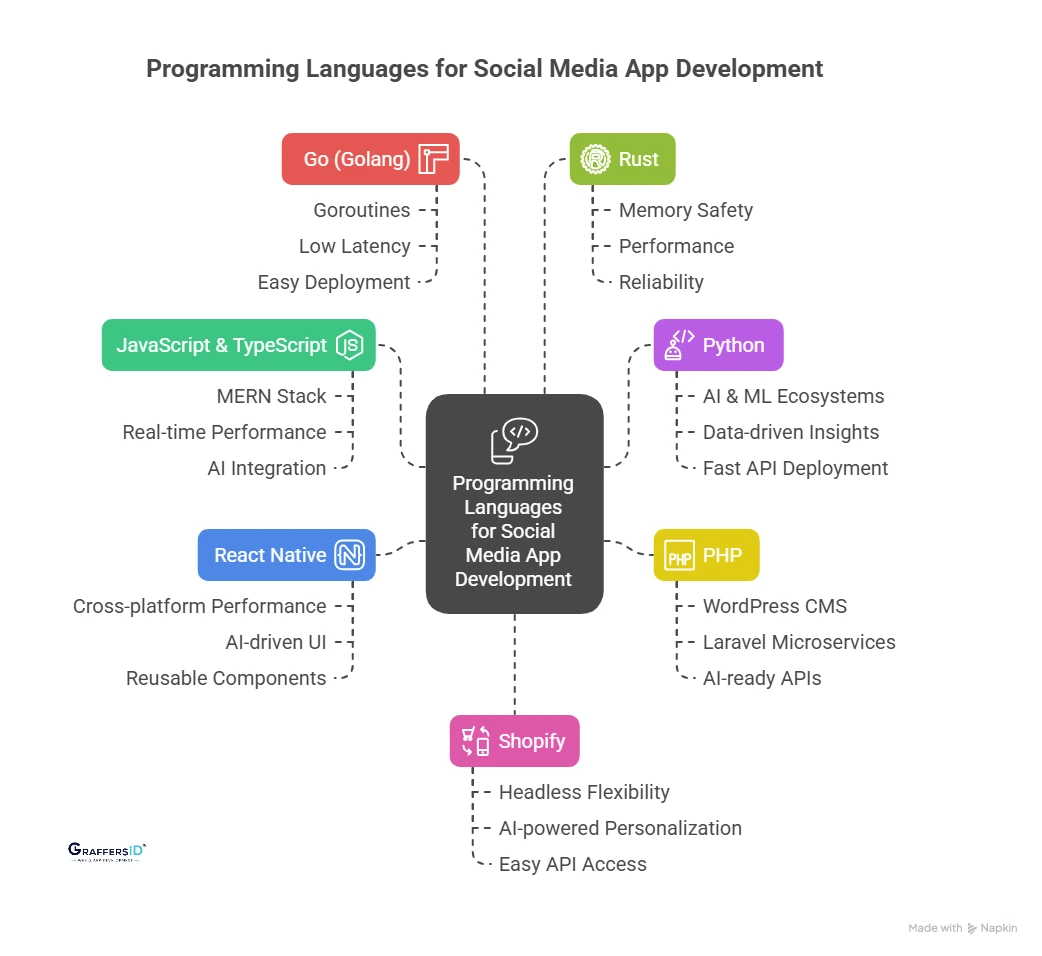
1. JavaScript & TypeScript: Node.js + React.js + MERN Stack
JavaScript continues to power most of the world’s social apps, and TypeScript has now become the standard for large-scale, AI-integrated web systems. The MERN stack (MongoDB, Express, React, Node.js) offers a complete ecosystem for full-stack development, ensuring scalability and real-time responsiveness.
Key Advantages:
-
Unified ecosystem: Build both frontend and backend with one stack.
-
Real-time performance: Socket.IO, NestJS, and Next.js make it ideal for chat, notifications, and live updates.
-
AI integration: Works smoothly with AI APIs and Node-based AI SDKs for recommendations and personalization.
-
Cross-platform capabilities: React Native extends the same language to mobile apps.
Looking to build a real-time, AI-powered social media platform with Node.js and React.js? Hire top MERN adevelopers from GraffersID today and bring your social app vision to life!
Ideal For:
-
Real-time chat systems, live notifications, and feed management.
-
Interactive dashboards and mobile-friendly user experiences.
Used By: Facebook, Twitter, LinkedIn, and emerging AI-powered networks.
2. Python: AI, Machine Learning & Content Intelligence
Python powers the AI backbone of most modern social networks. From recommendation engines to content moderation and natural language understanding, it’s the go-to for AI-driven automation.
Key Advantages:
-
AI & ML ecosystems: TensorFlow, PyTorch, Hugging Face, and OpenAI integrations.
-
Data-driven insights: Ideal for user analytics, behavior prediction, and sentiment tracking.
-
Fast API deployment: Frameworks like FastAPI and Django accelerate backend delivery.
Best For:
-
Personalized feed algorithms, chatbot systems, and content moderation pipelines.
Used By: Instagram, Reddit, and YouTube for AI-driven user experiences.
3. PHP: Laravel + WordPress for Scalable Communities
PHP, especially with Laravel and modern WordPress, continues to serve community-driven platforms and content-heavy social systems. With new PHP 8+ updates, it’s faster, more secure, and cloud-friendly.
Key Advantages:
-
Proven CMS strength: WordPress remains the most flexible CMS for social-community sites.
-
Laravel microservices: Enable modular backend architectures for scalability.
-
AI-ready APIs: PHP now integrates easily with AI APIs via REST/GraphQL layers.
Best For:
-
Building social community websites, influencer platforms, or private social intranets.
Used By: Facebook (originally PHP), Slack (PHP microservices), WordPress communities.
4. React Native: Cross-Platform Mobile Social Apps
React Native remains the most efficient framework for building iOS and Android apps with a single codebase, crucial for startups aiming for rapid growth.
Key Advantages:
-
Cross-platform performance: Native-like experience for both iOS and Android.
-
AI-driven UI: Integrate with TensorFlow Lite and on-device AI features.
-
Reusable components: Faster updates and consistency across platforms.
Looking to build high-performance, cross-platform social apps quickly? Hire expert React Native developers from GraffersID to create scalable, dynamic, and AI-ready mobile applications for iOS and Android.
Best For:
-
Mobile-first social networking apps with chat, video, and interactive feeds.
Used By: Instagram, Discord, Pinterest, and new-age social startups.
5. Go (Golang): High-Concurrency Backends
Go has become a developer favorite for real-time backend systems and high-load microservices, perfect for handling millions of concurrent users.
Key Advantages:
-
Goroutines: Lightweight threads for real-time messaging and streaming.
-
Low latency: Ideal for large-scale chat or notification services.
-
Easy deployment: Static binaries simplify scaling across cloud environments.
Best For:
-
Real-time communication, live streaming, and user activity feeds.
Used By: Meta, Twitch, and YouTube for backend concurrency.
6. Rust: High-Security & Low-Latency Modules
In a privacy-first, AI-powered social media era, Rust ensures memory-safe, high-speed performance for modules that demand security and precision.
Key Advantages:
-
Memory safety: Eliminates vulnerabilities common in C/C++.
-
Performance: Near-native speed, ideal for video/audio systems.
-
Reliability: Excellent for encryption and authentication modules.
Best For:
-
Video encoding, WebRTC features, and real-time content delivery modules.
Used By: Discord, Dropbox, and new decentralized social platforms.
7. Shopify: Social Commerce Integration
Social media and e-commerce are merging fast. With Shopify APIs and headless integrations, developers can embed social commerce features directly into apps.
Key Advantages:
-
Headless flexibility: Integrates social feeds with storefronts.
-
AI-powered personalization: Product recommendations and influencer integrations.
-
Easy API access: Works well with Node.js, React, and TypeScript frontends.
Best For:
-
Social networks blend community engagement with eCommerce experiences.
Used By: Pinterest, Instagram Shops, and creator-led platforms.
Comparison Table: Top 7 Programming Languages for Social Media App Development in 2026
| Language / Stack | Best Use Case | Key Strengths | Used By |
|---|---|---|---|
| Node.js / TypeScript | Real-time APIs, chat, and feeds | Event-driven, scalable, full-stack JS | LinkedIn, Twitter |
| React.js / React Native | Dynamic UI, cross-platform apps | Component reusability, mobile-ready | Instagram, Pinterest |
| Python | AI features & analytics | ML frameworks, NLP, and moderation | Instagram, YouTube |
| PHP / WordPress | Social communities, CMS | Content scalability, quick deployment | WordPress, Slack |
| Go | Backend microservices | Concurrency, low latency | Twitch, Meta |
| Rust | Secure, high-performance modules | Memory-safe, fast execution | Discord, Dropbox |
| Shopify (Liquid) | Social commerce | Headless APIs, easy integration | Instagram Shops |
Real-World Examples: How Top Social Media Platforms Use These Languages (2026)
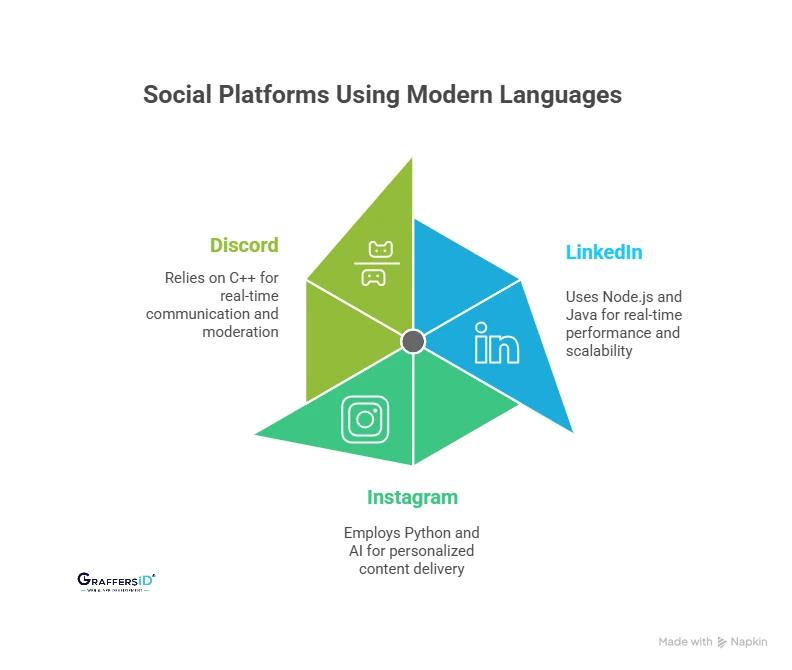
1. LinkedIn: Real-Time Performance with Node.js and Java
LinkedIn uses a hybrid tech stack of Node.js and Java to deliver secure, real-time experiences for its global user base.
-
Node.js powers the platform’s notification and messaging systems, ensuring low latency and instant data synchronization.
-
Java handles enterprise-grade scalability and security, managing millions of concurrent connections.
Together, they enable LinkedIn to offer fast, reliable, and data-compliant networking for professionals worldwide.
2. Instagram: AI-Powered Personalization with Python
Instagram relies heavily on Python and its AI ecosystem to personalize user feeds and recommendations.
-
TensorFlow and PyTorch help train large-scale recommendation models.
-
Django ensures backend scalability, powering billions of image and video uploads daily.
This combination allows Instagram to deliver hyper-personalized content and smooth performance across devices.
3. Discord: Real-Time Communication Engine with C++
Discord, one of the fastest-growing community platforms, uses C++ to maintain real-time, low-latency voice and video streaming.
-
Its WebRTC implementation is optimized in C++ for instant communication between millions of active users.
-
This performance-focused approach supports AI-driven moderation and live audio processing, critical for safe, lag-free user interaction.
Future Trends in Social Media App Development: 2026 & Beyond
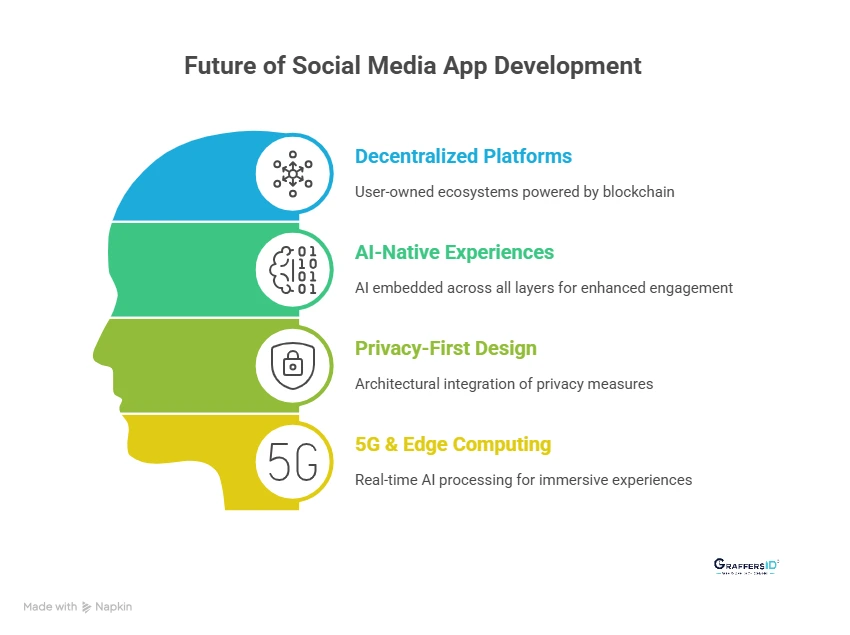
1. Decentralized Platforms (Web3 + Blockchain)
The next generation of social media is moving toward user-owned ecosystems, powered by blockchain.
-
Smart contracts enable transparent content ownership and monetization.
-
Web3 social apps prioritize decentralized storage, digital identity, and censorship resistance.
2. AI-Native Experiences
AI is now embedded across every layer of social networking platforms.
-
Generative AI enhances content creation, filters, and user engagement.
- Agentic AI systems manage content moderation, trend prediction, and automated support.
This shift from “AI-assisted” to AI-native development defines the new social media era.
Read More: Agentic AI vs. Generative AI: Key Differences CTOs Must Know in 2026
3. Privacy-First & Compliant Design
Privacy isn’t optional anymore, it’s architectural.
-
Platforms are integrating end-to-end encryption and zero-trust frameworks.
-
Compliance with GDPR, CCPA, and upcoming AI governance acts is being built directly into backend systems.
Expect increased adoption of decentralized identity verification and user-controlled data layers.
4. 5G, Edge Computing, & Real-Time AI
As 5G networks expand, social platforms are moving toward edge-based AI processing.
-
Real-time video, AR filters, and live streaming now rely on distributed AI inference closer to the user device.
-
This drastically reduces latency and unlocks immersive, interactive experiences for the metaverse and social VR.
Conclusion: Build a Future-Ready Social Media Platform in 2026
In 2026, building a social media platform means combining speed, intelligence, and scalability, not relying on a single programming language. The winning tech stack blends performance-driven backends, AI-powered personalization, and seamless multi-platform support to deliver next-gen user experiences.
Here’s the ideal language mix for the modern era:
-
Node.js + React.js: Power real-time interactions, feeds, and responsive UIs.
-
Python: Enable AI recommendations, automation, and intelligent moderation.
-
Go + Rust: Build secure, lightning-fast, and highly scalable backend systems.
-
React Native / Swift / Kotlin: Ensure cross-platform, high-performance mobile apps.
-
PHP / WordPress integrations: Add community, content, or eCommerce extensions easily.
By orchestrating the right combination, you can create a platform that’s AI-driven, privacy-first, and built to handle millions of concurrent users, the foundation for sustainable growth in the evolving digital landscape.
At GraffersID, we connect you with the top 1% of vetted developers skilled in Node.js, React.js, Python, and AI integrations. Our teams specialize in building secure, scalable, and future-ready social media platforms that thrive in the AI-first ecosystem of 2026.
Hire remote developers from GraffersID today and turn your social networking idea into an intelligent, high-performing digital reality.



